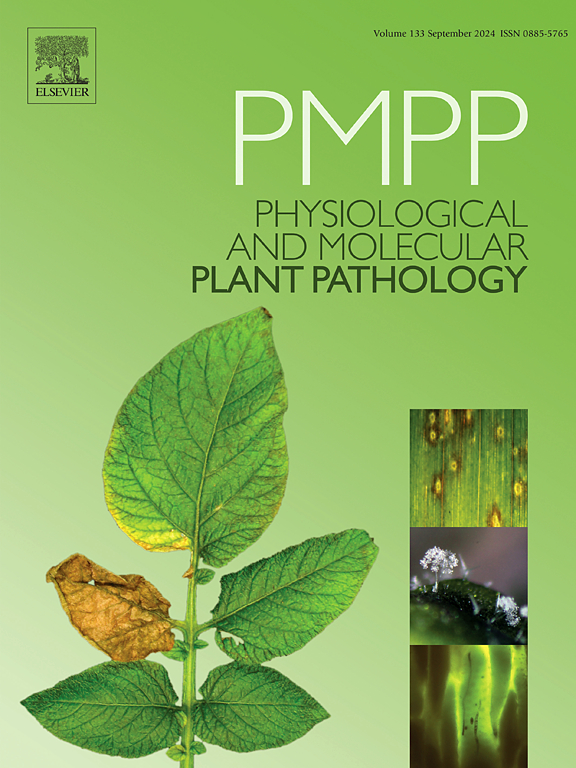引起巴西水稻纹枯病的一种新真菌——米紫角霉
IF 2.8
3区 农林科学
Q2 PLANT SCIENCES
引用次数: 0
摘要
水稻(Oryza sativa)是世界上种植和消费最多的谷物之一,对确保全球粮食安全至关重要。疾病是限制水稻产量提高的诸多因素之一。目前,水稻纹枯病是一些国家水稻作物中最重要的病害之一,据报道有3种根丝核菌(R. solani AG-1 IA、R. oryzae和R. oryzae-sativae)可引起水稻纹枯病。然而,在2021/22年收获期间,在巴西南里约热内卢Grande do发现了一种新的病原体,导致水稻种植区出现纹枯病症状。从有症状的水稻植株中分离得到该真菌,并对其进行了形态和分子表征。通过形态学特征分析和its序列(nuc rDNA ITS1-5.8S-ITS4)和rpb2 (rpb2 - 980f和fRPB2-7cR)与GenBank平台上的序列数据库比对,采用BLASTn算法对该真菌分离物进行初步鉴定,认为该真菌可能是Ceratobasidium的新种。因此,进行了系统发育分析来证实我们的假设。在所有生成的树中,获得的分离物被分配到不同的、支持良好的枝,后验概率(PP)和Bootstrap值(BS)大于70。此外,我们还将这些序列与另一种水稻分离物Ceratobasidium sp. C484的序列进行了比较,结果表明它们的相似性大于在不同种间观察到的相似性。根据这些结果,我们提出了一个新的角鼻虫种,命名为oryzicola。致病性试验证实该新种还能引起水稻的纹枯病。这是对世界上尚未发现的角鼻虫新种的首次描述。这种与其他种类的根丝核菌症状相同的新病原体的鉴定对实施正确的管理措施和水稻遗传改良计划具有极其重要的意义。本文章由计算机程序翻译,如有差异,请以英文原文为准。
Ceratobasidium oryzicola, a new fungal species causing sheath blight on rice in Brazil
Rice (Oryza sativa) is among the most cultivated and consumed cereals in the world, and is of vital importance in ensuring global food security. Diseases are among the many factors limiting the increase in rice productivity. Currently, three species of Rhizoctonia (R. solani AG-1 IA, R. oryzae and R. oryzae-sativae) have been reported as causing sheath blight in rice, being one of the most important diseases in rice crops in several countries. However, in the 2021/22 harvest, a new pathogen was found in Rio Grande do Sul, Brazil, causing symptoms of sheath blight in a rice planting area. The fungus was isolated from symptomatic rice plants and morphologically and molecularly characterized. The initial identification of the fungal isolate was carried out by analyzing its morphological characteristics and contrasting the ITS sequences (nuc rDNA ITS1-5.8S-ITS4) and rpb2 (RPB2-980F and fRPB2-7cR) with the sequence database available on the GenBank platform, using the BLASTn algorithm, as a probable new species of Ceratobasidium. Therefore, phylogenetic analyses were carried out to confirm our hypothesis. The isolate obtained was allocated to distincts, well-supported clades with Posterior Probability (PP) and Bootstrap values (BS) above 70 in all trees generated. Moreover, we also compared these sequences of C. oryzicola to those of Ceratobasidium sp. C484, another rice-derived isolate, demonstrating that their similarity is greater than that observed among strains of Ceratobasidium ramicola species. With these results we propose a new Ceratobasidium species named Ceratobasidium oryzicola. The pathogenicity test confirmed that this new species also causes sheath blight in rice crops. This is the first description of this new species of Ceratobasidium that had not yet been identified in the world. The identification of this new pathogen, causing symptoms identical to those of other species of Rhizoctonia, is extremely important for implementing correct management measures and for rice genetic improvement programs.
求助全文
通过发布文献求助,成功后即可免费获取论文全文。
去求助
来源期刊
CiteScore
4.30
自引率
7.40%
发文量
130
审稿时长
38 days
期刊介绍:
Physiological and Molecular Plant Pathology provides an International forum for original research papers, reviews, and commentaries on all aspects of the molecular biology, biochemistry, physiology, histology and cytology, genetics and evolution of plant-microbe interactions.
Papers on all kinds of infective pathogen, including viruses, prokaryotes, fungi, and nematodes, as well as mutualistic organisms such as Rhizobium and mycorrhyzal fungi, are acceptable as long as they have a bearing on the interaction between pathogen and plant.

 求助内容:
求助内容: 应助结果提醒方式:
应助结果提醒方式:


